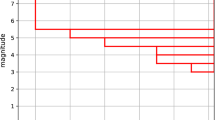Abstract
A probabilistic model is presented to quantify parameters that define the exceedance rates of earthquake magnitudes. Incompleteness of seismic catalogues and superposition of Poisson-renewal earthquake generation processes are both taken into account within a Bayesian framework. The formulation can be transformed into the parameter estimation of single Poisson or renewal process. The incomplete exceedance rate parameters are estimated from incomplete data, so that the estimated values are equal to those of the complete rate. Two cases are studied: the first one corresponds to a seismic source in the Gulf of Mexico and the other to a seismic source in the southern Pacific coast of Mexico.




Similar content being viewed by others
References
Alamilla JL, Esteva L, García-Pérez J, Díaz-López O (2001) Simulating earthquake ground motion at a site, for given intensity and uncertain source location. J Seismology 5:475–485
Alamilla JL, Vai R, Esteva L (2014a) Seismicity assessment using earthquake catalogues with uncertain and incomplete data: probabilistic formulation. J Seismology. doi: 10.1007/s10950-014-9438-z
Alamilla JL, Vai R, Esteva L (2014b) Completeness assessment of earthquake catalogues under uncertain knowledge. J Seismology. doi:10.1007/s10950-014-9448-x
Anagnos T, Kiredmidjian AS (1988) A review of earthquake occurrence models for seismic hazard analysis. Prob Eng Mech 8(1):3–11
Cornell CA (1969) Engineering seismic risk analysis. Bull Seis Soc Am 58:1583–1606
Cornell CA, Vanmarcke E (1969) The major influences on seismic risk. In: 4th World conference on earthquake engineering. Santiago de Chile
Cornell CA, Winterstein S (1988) Temporal and magnitude dependence in earthquake recurrence models. Bull Seis Soc Am 78(4):1522–1537
Cox DR (1962) Renewal theory. Methuen
Cox DR, Isham V (1980) Point processes Monographs on applied probability and statistics. Chapman and Hall Ltd., New York
Díaz O, Garcída-Pí9rez J, Esteva L, Singh SK (1999) Accounting for source location errors in the Bayesian analysis of seismicity and seismic hazard. J Seismology 3:153–166
Esteva L (1968) Bases para la formulación de decisiones de diseño sídsmico. National Univeristy of Mexico, Doctoral thesis, Faculty of Engineering
Esteva L (1969) Seismicity prediction: a Bayesian approach. In: Congreso Mundial de Ingenierída Sídsmica. Santiago de Chile
Esteva L (1970) Consideraciones prácticas en la estimación bayesiana de riesgo sídsmico. In Serie Azul del Instituto de Ingenierída, no 248. UNAM, pp 209–218
Esteva L (1976) Seismicity. Seismic risk and engineering decisions. Elsevier, New York. chap 6
Gutenberg B, Richter CF (1944) Frequency of earthquakes in California. Bull Seis Soc Am 34(4):185–188
Jara JA, Rosenblueth E (1988) The Mexico earthquake of September 19, 1985—probability distribution of times between characteristic subduction earthquakes. Earthquake Spectra 4(3):499–529
McCaffrey R (2008) Global frequency of magnitude 9 earthquakes. Geology 36(3):263–266
McGuire RK (1995) Probabilistic seismic hazard analysis and design earthquakes: closing the loop. Bull Seis Soc Am 85(5):1275–1284
McGuire RK (2008) Probabilistic seismic hazard analysis: early history. Earthquake Eng Struct Dyn 37(3):329–338
Mignan A (2012) Functional shape of the earthquake frequency-magnitude distribution and completeness magnitude. J Geophys Res 117 (B08302)
Ogata Y, Katsura K (1993) Analysis of temporal and spatial heterogeneity of magnitude frequency distribution inferred from earthquake catalogs. Geophys J Int 113:727–738
Ogata Y, Katsura K (2006) Immediate and updated forecasting of aftershock hazard. Geophys Res Lett 33(10)
Page MT, Carlson JM (2006) Methodologies for earthquake hazard assessment: model uncertainty and the WGCEP-2002 forecast. Bull Seis Soc Am 96(5):1624–1633
Page MT, Dunham EM, Carlson JM (2005) Distinguishing barriers and asperities in near-source ground motion. JGR - Solid Earth 110(B11302)
Page MT, Custódio SR, Archuleta J, Carlson JM (2009) Constraining earthquake source inversions with GPS data 1: resolution based removal of artifacts. JGR - Solid Earth 114 (B01314)
Page MT, Alderson D, Doyle J (2011) The magnitude distribution of earthquakes near southern California faults. JGR - Solid Earth 116 (B12309)
Ringdal F (1975) On the estimation of seismic detection thresholds. Bull Seis Soc Am 65(6):1631–1642
Rosenblueth E, Ordaz M (1987) Use of seismic data from similar regions. Earthquake Eng Struct Dyn 15:619–634
Singh SK, Rodrídguez M, Esteva L (1983) Statistics of small earthquakes and frequency of occurrence of large earthquakes along the Mexican subduction zone. Bull Seis Soc Am 73(6):1779–1796
Woessner J, Wiemer S (2005) Assessing the quality of earthquake catalogues: estimating the magnitude of completeness and its uncertainty. Bull Seis Soc Am 95(2):684–698
Wu S, Cornell CA, Winterstein R (1995) A hybrid recurrence model and its implication on seismic hazard results. Bull Seis Soc Am 85(1):1–16
Author information
Authors and Affiliations
Corresponding author
Appendix: Occurrence probability of seismic events
Appendix: Occurrence probability of seismic events
The probability of occurrence of seismic events associated with renewal processes, whose probability density function of times between events is Gamma, can be obtained as follows.
The Laplace transform f ∗(s) of the Gamma probability density function can be expressed as (𝜃/s+𝜃)η, with parameters 𝜃=λ/V 2 and η=1/V 2, linked to the rate λ and coefficient of variation V of the times between seismic events. Similarly, if the random variable W n =T 1+T 2+…+T n describes the time to the n-th seismic event, where the times between events T=T 1=T 2=…=T n , are characterized by the Gamma probability density function with parameters 𝜃 and η, then the Laplace transform of the probability density function of W n is expressed as (𝜃/s+𝜃)nη. This implies that the probability density function of W n is Gamma and can be expressed as follows:
Thus, the cumulative distribution function W n is obtained as follows:
Γ(⋅,⋅) is the incomplete Gamma function and Γ(⋅) is the Gamma function. According to renewal theory (Cox 1962), the occurrence probability of the N=n seismic events at time t is estimated by the following expression:
This probability can be expressed in terms of λ and V:
Rights and permissions
About this article
Cite this article
Alamilla, J.L., Vai, R. & Esteva, L. Estimating seismic-source rate parameters associated with incomplete catalogues and superimposed Poisson-renewal generating processes. J Seismol 19, 55–68 (2015). https://doi.org/10.1007/s10950-014-9450-3
Received:
Accepted:
Published:
Issue Date:
DOI: https://doi.org/10.1007/s10950-014-9450-3




